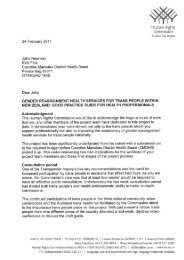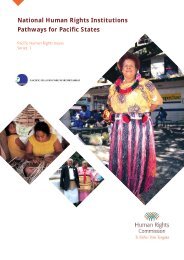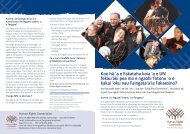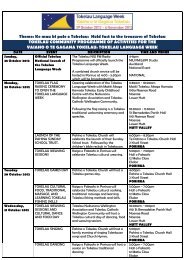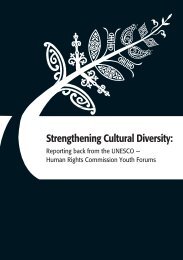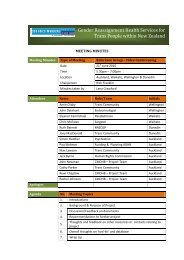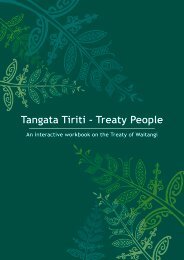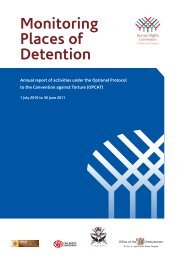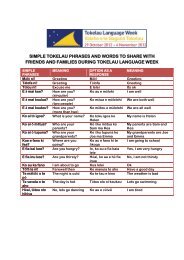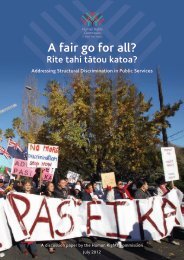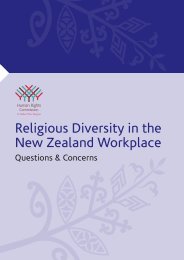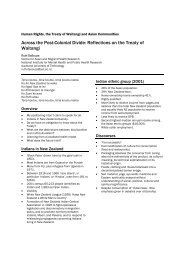Settling In Palmerston North and Feilding - Human Rights Commission
Settling In Palmerston North and Feilding - Human Rights Commission
Settling In Palmerston North and Feilding - Human Rights Commission
Create successful ePaper yourself
Turn your PDF publications into a flip-book with our unique Google optimized e-Paper software.
Appendix 4Diversity in the Workplace – A Summary of Local Research FindingsWorkforce Composition <strong>and</strong> Diversity Management in New Zeal<strong>and</strong> OrganisationsAn interim report – Manawatu FindingsResearch Background <strong>and</strong> MethodologyParticipation in the project was initiated by the Office of Ethnic Affairs in conjunction with Vision Manawatu <strong>and</strong> the Manawatu Chamber of Commerce toconduct research with employers to gain an underst<strong>and</strong>ing of diversity in the local work environment <strong>and</strong> how best to harness the benefits of cultural diversityfor business success <strong>and</strong> regional economic growth. The research contributes to a cross-national study of organisational diversity in New Zeal<strong>and</strong>, Austria <strong>and</strong>The Netherl<strong>and</strong>s, led by Dr Astrid Podsiadlowski, a research fellow with the Centre for Applied Cross-cultural Research, Victoria University of Wellington. DrPodsiadlowski is currently located at the University of Business <strong>and</strong> Economics in Vienna. The research is funded by the Research <strong>Commission</strong> of the EuropeanUnion. An invitation to participate in the research was circulated through Vision Manawatu <strong>and</strong> the Manawatu Chamber of Commerce to their business networks.The questionnaire was provided online <strong>and</strong> in hard copy. 73 questionnaires were completed. A good representation (over 50%) of owners/directors <strong>and</strong> generalmanagers participated in the survey.Key Findings for the Manawatu Region• The majority of organisations surveyed have fewer than 19 employees.• These organisations are predominantly described as ‘diverse’.• Diversity is integrated across all levels of these organisations.• Employers with more diverse workforces are more satisfied with their employees’ performance. That is, they see the potential in their diversity <strong>and</strong> make gooduse of their talent for the benefit of their business.• Employers with more diverse workforces are more likely to have more intercultural contact, <strong>and</strong> express a stronger multicultural ideology 49 <strong>and</strong> culturalempathy 50 .• Where cultural diversity is perceived as a threat, for example to New Zeal<strong>and</strong> culture, quality of education or a person’s own living conditions, the effect ofdiversity on work performance is assessed negatively.• Some migrants groups are perceived as more favourable. This perception may affect their chances of securing employment. Favourability is linked tofamiliarity, that is, there is a tendency to feel more comfortable with people whom we perceive as similar to us. The more familiar people feel with certainmigrant groups, the more likely they are to relate to them <strong>and</strong> perceive them as fitting into their organisation.• The benefits of diversity were expressed as (in order of priority): creating a more interesting workplace; contributing new ideas; providing a multi-lingualatmosphere; representing the cultural diversity of their customer base.• The costs of diversity were expressed as (in order of priority): extra training efforts; time costs; cultural differences; financial costs.• Survey participants reported an improvement in performance over the last 3 years (compared to other organisations in the same business). Improvedperformance included: customer satisfaction; product quality; marketing; productivity; sales growth; sales volume; market share; performance in the nationalmarket.• ‘Performance on international markets’ is the lowest rated response on the question of ‘organisational performance’. This response may largely depend on anorganisation’s objectives <strong>and</strong> the services or products it offers, but it may also mean that for some of the participating organisations, there is the potential toharness the diversity within their organisations to extend their business into international markets.• Employers that report satisfaction with the diversity within their organisations emphasise the following strengths (in order of priority): high motivation <strong>and</strong> goodwork ethics; high level of commitment; relief from skills shortages; high reliability.Recommendations• The population profile of New Zeal<strong>and</strong> shows that we are a multi-cultural nation. Growth in our future labour force will predominantly come from our Maori,Pacific <strong>and</strong> other migrant populations. As New Zeal<strong>and</strong>ers we need to embrace diversity as a fact of life.• The reported positive impact of diversity on business outcomes presents a business case for a diversified workforce. Other research shows that diversitybrings a higher risk of miscommunication <strong>and</strong> stress but managed well can outperform a more homogeneous workforce.• If an organisation has a workforce that mirrors its markets, it is more likely to have the language skills, cultural underst<strong>and</strong>ing, networks <strong>and</strong> experience torespond appropriately to its customers to the ultimate benefit of the business.• Valuing the contribution of diversity (such as multi-languages, cultural knowledge, new perspectives) will unlock an employer’s perspective to regard the highavailability of migrant job seekers as potential c<strong>and</strong>idates. (This fact was not acknowledged in the survey.)• Harnessing diversity successfully in business calls for proactive, fresh thinking in business strategies <strong>and</strong> in our human resource management practices.• A diverse workforce will improve an organisation’s potential to broaden their pool of applicants. Diverse groups of employees are attracted to organisationswhere they see people ‘like them’ in the workforce, at senior levels of the organisation <strong>and</strong> as role models <strong>and</strong> spokespersons.• There is further potential to diversify the workforce for those organisations that describe themselves as ‘quite diverse’.• <strong>In</strong>creasing an employer’s familiarity <strong>and</strong> knowledge of other ethnic groups may improve their favourability for employment. Employers may also need support<strong>and</strong> training to underst<strong>and</strong> <strong>and</strong> manage diversity <strong>and</strong> cultural differences.• Small-to-medium-sized organisations may need some external support to accommodate migrant needs, such as mentoring, training or language classes.• Migrant job seekers share the responsibility with the receiving community, to adapt to the New Zeal<strong>and</strong> work environment.Appendix 5Engaging Asian Communities in New Zeal<strong>and</strong> – Key Findings from a Report Prepared for theAsia New Zeal<strong>and</strong> Foundation in 2005This research undertaken on behalf of the Asia New Zeal<strong>and</strong> Foundation considers the nature <strong>and</strong> models of engagement of Asian communities <strong>and</strong> characteristicsof successful engagement. The information was drawn from 17 general focus groups (94 participants in total), 26 specific interviews <strong>and</strong> 10 general interviews withSupported by <strong>Settling</strong> <strong>In</strong>



